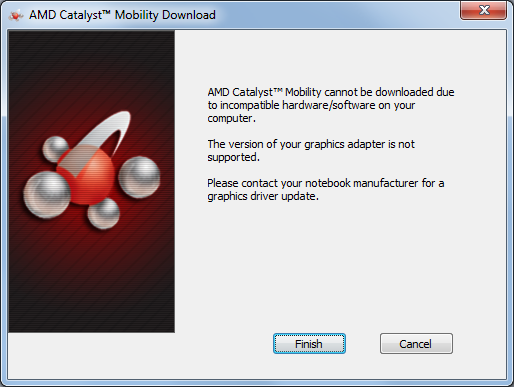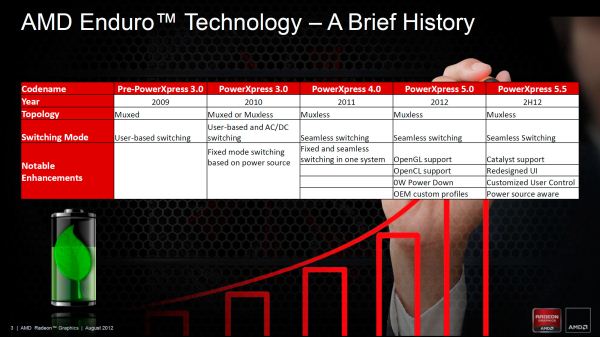AMD’s Enduro Switchable Graphics Levels Up
by Jarred Walton on September 6, 2012 3:00 AM ESTRecap: AMD’s PowerXpress, aka Dynamic Switchable Graphics, aka Enduro
Getting back to the switchable graphics, AMD has gone through a variety of names over the years. Here’s AMD’s summary slide, which I’ll discuss in detail:
Originally introduced as PowerXpress back in 2008, the first AMD switchable graphics solutions were like that found later in the ASUS UL80Vt and similar laptops: you had to flip a switch, and in the first iterations you would then need to reboot the laptop so that the BIOS could disable the discrete GPU and activate the integrated GPU. It was messy and a bit inconvenient, and NVIDIA’s early studies showed that many users ended up not using the feature—they would either run on dGPU all the time or on iGPU all the time. Both AMD and NVIDIA had a second series of switchable graphics designs where the need to reboot was removed; the first Alienware M11x could switch GPUs in about 10-15 seconds, and the same was true of HP’s first ENVY laptops. These were using PowerXpress 2.0 and 3.0, and for most people the switching side was adequate: you’d run on dGPU when plugged in and switch to iGPU when on battery power.
Last year, AMD took a step forward with their switchable graphics by introducing PowerXpress 4.0, which also renamed the technology to Dynamic Switchable Graphics (DSG for short). I got a chance to do a head-to-head of the technology using a Sony VAIO C laptop provided by NVIDIA. You know a company is confident that they’re going to win a technology comparison when they’ll actually give you a competitor’s product. In some cases, DSG was just as good as Optimus: you could launch a supported game and never realize all the extra stuff happening in the background; unfortunately, there were several titles where it wasn’t quite as convenient as we would have liked, and OpenGL support from DSG was completely missing.
Step forward to early 2012 and we got another update to PowerXpress 5.0 (note that PowerXpress is now only used internally by AMD and hasn’t been their marketing name since before PX4.0) along with a rechristening: Dynamic Switchable Graphics was out and Enduro was in. If nothing else, at least it makes my job easier as Enduro is much more concise. There's also the fact that the GPUs are no longer "switching", as the iGPU is always running; now the dGPU is simply supplementing the iGPU when needed. Along with the name change, AMD added OpenGL and OpenCL support to the mix, and with their Zero Core Technology (which is also part of their 7000 series desktop GPUs—a case of mobile design influencing desktops) the need to keep a small portion of the chip alive (aka BACO: Bus Active Chip Off) was removed. OEMs could also ship with custom profiles for applications, so for example Dell might want all of their extra utilities to default to running on the iGPU.

Hopefully this problem goes away next month!
Other than those changes, the UI and driver updates situation on early Enduro solutions remains largely the same as with DSG/PX4.0—and that’s what I initially received with the Clevo P170EM, with drivers from around March 2012. A quick check at AMD’s site also let me know that there weren’t any new drivers available, as the P170EM wasn’t currently supported by the latest Mobility Catalyst drivers.











200 Comments
View All Comments
HOODY - Saturday, September 15, 2012 - link
I think this would be great for AMD, and would let users download “regular” AMD updates again as before this idiotic manufactures only OEM updates insanity. As far as I’m concerned they can even make a driver that just disables the NVIDIA chip altogether. thanks for that info,it needs to also be placed in the 7690M XT forum http://h30434.www3.hp.com/t5/Notebook-Display-and-...
HOODY - Saturday, September 15, 2012 - link
Someone mentioned to me that this was not for "powerplay switchable", shrug, All I know is the article only mentions "Switchable" nothing about powerplay, I haven't even heard or seen that term on any other forum about this switchable stuff. All it says is that the name ENDURO is now what they call Switchable.I'm also not clear just where this 7690M XT card would fall, as its just a re done 6770M, so I don't know if it would be picked up by AMD as a 7xxxx series or not either, I do know that AMD doesn't even recognize the card at all now. BTW this thing (7690M XT) is supposed to be @900MHz too, but its only showing @800MHz, so even that's misleading.
I will be upgrading my W7 home prem to W8 Pro anyway come next month, and I assume HP will have some sort of driver cobbled together by than for us OEM'ers, it will be interesting how all this shakes out with so many complaints over this switchable stuff, I wish they would just go back to true dedicated video cards and let the card makers do the drivers. I mean man, with all this technology today, one video type either ATI or NVIDIA should be able to make a single card that is able to power down automatically when it senses battery power.
JarredWalton - Tuesday, September 18, 2012 - link
PowerPlay is the technology that conserves power on the GPU when on battery power, even with the GPU still active. Basically, it lowers clocks and performance when enabled. Enduro is a separate technology to disable the dGPU completely (power it down) when it's not needed.HOODY - Tuesday, September 18, 2012 - link
OK so than just what type is on my machine? and is this new driver stuff going to be useable on my setup? Or am I still stuck with OEM crap.Radeon 7690M XT and Intel 3000, the Intel is the chip the unit switches to if on battery, the Radeon is what it uses when plugged in or switched for games. I have it set to "fixed" for now so it uses just the Radeon. But it does still ask to switch to the Intel if I unplug it the wall and go on battery.
This is a HP dv7t its still using the driver dated Nov 2011, I know about the russian site guy with the mod'ed drivers he comes up with, but they aren't exactly instalable either without having to mix and match, as one doesn't take the CCC, one doesn't take the newer Intel driver. I was hoping that this Enduro stuff was going to be the fix for people withnthis setup, to be able to again download drivers directly from AMD as they update, since waiting for these damned manufactures sucks.
2670QM
8g ram
1920x1080
W7 hp
JarredWalton - Sunday, September 30, 2012 - link
Technically, the HD 3000 (or HD 4000 on Ivy Bridge) is always enabled and running the video outputs. The 7690M only powers on when needed and it copies data over the PCIe bus into system memory or takes over some of the display ports or something funky. If you're able to configure dynamic switchable graphics, you have a PowerXpress 4.0 or later laptop and you should (eventually) get support from the Mobility Catalyst Enduro stuff.If you can only manually switch (e.g. based on power source), you're running PowerXpress 3.0 and are basically out of luck for drivers. AMD/Microsoft/Intel will probably put together one initial driver for Windows 8 to get you up and running, but I wouldn't count on anything beyond that.
Note that I am pretty sure the dv7 is a PowerXpress 4.0 laptop, so you should be okay (at some point).
TrantaLocked - Monday, October 1, 2012 - link
Jarred, I have a question that I hope AMD will feel comfortable answering if you can get in contact with them.The new-ish data transfer process (you yourself wrote about it here: http://www.anandtech.com/show/2934/nvidia-optimus-... that Nvidia used involved a hardware feature called the Optimus Copy Engine that allowed asynchronous data transferring over the PCIe bus. Before that was implemented, it was noted that as the frame rate increased in a game, the noticeable the decrease in performance became, just as it is happening NOW with AMD.
My question is simple: did AMD implement such a hardware feature, and that the feature simply needs better driver support? I trust AMD is going to fix the problem, but it seems like this issue is exactly what was happening with Nvidia...as if the hardware feature that AMD *should* have implemented isn't even being used. It troubles me that if it was implemented that AMD didn't make sure such an important feature was being driven properly.
Vozier - Sunday, September 30, 2012 - link
Here's a small post with info about the underutilization issue fix:[QUOTE=caveman-jim;8864455]Word from AMD tonight is that internal testing is going well and there is hope for a public beta driver in the next two weeks or so, maybe sooner. Sorry nothing more, that's all my connections give me.[/QUOTE]
26 SEPT.
Dido767 - Tuesday, October 23, 2012 - link
Helpppp....I can't find a way to get CS6 after effects to recognize my 7970m. I wasted hours looking for a solution but nothing!!! my dxdiag only see my onboard Intel 4000 adapter. The GPU sniffer utility that comes within the AE folder doesn't recognize the AMD as well.
Is there some workaround that I can try??
It's really frustrating because one of the reasons that I bought this laptop is for some graphic design projects and of course I want to the get most out of my card.
Anyone? plz!!
Pablito Que - Thursday, December 13, 2012 - link
I bought an AVA bare bones P150EM With the Radeon 7970m.I wondered about updating the graphics driver the moment I got it, but I called AVA Direct first because I had heard there were problems with the drivers in doing so.
This is what he told me:
"The drivers pre-installed on your computer are drivers made to interact at best performance with the intergraded graphics card on the mother board(HD graphics 4000). DO NO ATTEMPT TO DOWNLOAD AND INSTALL THE UPDATE ON AMD'S WEBSITE. THEY WILL NOT WORK PROPERLY. We try to make this clear to all who purchase the P150EM and 170, but they do not listen and think they've got it figured out. They go ahead and download the updates and the card fails! Everyone who calls us complaining about performance has tried to update the drivers when we warned them not to."
Since I have had my computer, I have had the drivers that it came with and with a 3710QM running ar 3.2 and 8 gig of RAM at 1600Mhz, I'm getting Metro 2033 at 29.9 fps with 1920x1080 and all setting maxed out minus Anti-alaising. My card has just the stock drivers and it out performs the 680M on a number of major games and was over 50% cheaper than the 680M. There's NO logical argument anyone could make for choosing the 680M over the 7970m, especially driver support issues! If the lame stock drivers already out perform Nvidia's best, then what will happen when the refined drivers are realeased? And when I say that the stock drivers out perform Nividia's, I mean in terms of frame rate from game to game- which is the ONLY thing that matters in the end.
ZippityD - Saturday, January 12, 2013 - link
Well, on my NP170EM I'm still having AMD issues with their 7970M card.I regret purchasing this card last summer. Unlike others who had problems upon updating, I began to have BSOD problems (turned out to be caused by the AMD driver) this January. The horrid trip through AMD's enduro systems has resulted in much stress and little help.
Vote with my wallet from now on, I suppose.